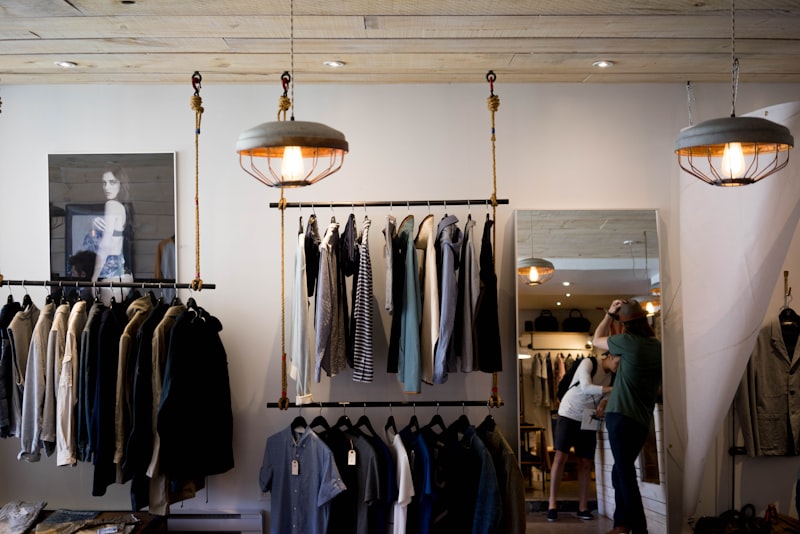Imagine a world where you walk into a store and it feels like stepping into a scene from a sci-fi movie. Smart shelves detect your presence and display product information instantly, while virtual reality lets you try on clothes without changing a single garment. This isn’t just fantasy; it’s the future of retail taking shape before our eyes.
Technology is at the heart of this transformation. Artificial intelligence (AI) and machine learning algorithms analyze vast amounts of consumer data to predict trends and personalize shopping recommendations. Whether you’re browsing online or in-store, these technologies ensure that every interaction feels tailored to your preferences.
But it’s not just about gadgets and gizmos. The future of retail is also about sustainability and social responsibility. Consumers are increasingly mindful of the environmental impact of their purchases, pushing brands to adopt eco-friendly practices and transparent supply chains. Shopping isn’t just about buying anymore; it’s about making choices that align with our values.
The rise of e-commerce has been a game-changer, allowing businesses to reach global audiences with ease. Online marketplaces offer endless choices and convenience, challenging traditional brick-and-mortar stores to rethink their strategies. Yet, physical stores aren’t going extinct; instead, they’re evolving into experiential hubs where shoppers can touch, feel, and experience products in ways that screens can’t replicate.
Customer expectations are higher than ever. They want seamless shopping experiences across multiple channels, from mobile apps to social media platforms. The future belongs to brands that can adapt quickly, innovate fearlessly, and put the customer at the center of everything they do.
Virtual Storefronts: How Augmented Reality is Revolutionizing Retail
Imagine stepping into a store without leaving your home, browsing through products as if they were right in front of you. This isn’t a scene from a sci-fi movie anymore; it’s the reality that augmented reality (AR) is bringing to retail. Virtual storefronts are transforming the way we shop by merging the physical and digital worlds seamlessly.

Augmented reality, or AR, enhances our perception of reality by overlaying digital information onto the physical environment. In retail, this technology allows customers to visualize products in their own space before making a purchase. Whether it’s trying out furniture in your living room or seeing how a new pair of shoes matches your outfit, AR bridges the gap between online shopping convenience and the tangible experience of traditional stores.
One of the most significant advantages of virtual storefronts powered by AR is the ability to try before you buy. Consumers can now see how products fit or look in real life without actually having them physically present. This not only increases confidence in purchasing decisions but also reduces the likelihood of returns, benefiting both customers and retailers alike.
Moreover, augmented reality creates immersive shopping experiences that captivate customers. Instead of scrolling through endless product images, shoppers can interact with 3D models and explore details up close. This interactive element not only engages users but also keeps them on the retailer’s platform longer, potentially leading to increased sales.
From a retailer’s perspective, virtual storefronts powered by AR open new doors for creativity in marketing and customer engagement. Brands can leverage AR to launch innovative campaigns that resonate with tech-savvy consumers. By offering unique experiences such as virtual fashion shows or interactive product demonstrations, companies can differentiate themselves in a crowded marketplace.

Augmented reality is more than just a technological novelty; it’s a game-changer for the retail industry. Virtual storefronts powered by AR are redefining how we shop, blending the convenience of online browsing with the experiential aspects of physical retail. As this technology continues to evolve, the possibilities for enhancing customer engagement and driving sales are limitless.
From Clicks to Bricks: Why Online Retailers Are Investing in Physical Stores
Picture this: You’re browsing through your favorite online store, adding items to your cart with a few clicks, enjoying the ease of doorstep delivery. Yet, something is missing. Maybe it’s the thrill of touching a product, trying it out, or getting instant gratification. That’s where physical stores come in—they bridge the gap between the virtual and the tangible.
In today’s fast-paced digital age, online retailers are recognizing the power of physical presence. It’s not just about selling products; it’s about creating immersive brand experiences. Imagine walking into a store designed like a sleek showroom where you can interact with products firsthand. You can feel the texture of that luxury sweater, test the weight of a new gadget, or even sample the aroma of freshly ground coffee beans.
But it’s not all about sensory experiences. There’s a strategic advantage too. Physical stores offer a strategic advantage too. They serve as hubs for returns and exchanges, providing instant customer support and building trust with face-to-face interactions. It’s like turning a click into a handshake, transforming virtual connections into lasting relationships.
Moreover, physical stores act as tangible touchpoints in a brand’s omnichannel strategy. They reinforce brand identity and increase visibility in saturated markets. A well-placed store can attract foot traffic and drive awareness, complementing online efforts with real-world impact.
In essence, the shift from clicks to bricks isn’t just a trend—it’s a strategic evolution. Online retailers are realizing that while digital platforms offer convenience, physical stores offer connection. They’re investing in these brick-and-mortar spaces to create holistic shopping experiences that blend the best of both worlds.
AI in Retail: How Smart Technology Is Personalizing the Shopping Experience
AI, or artificial intelligence, has seamlessly integrated into the retail landscape, transforming the shopping experience into something deeply personal. It’s like having a knowledgeable assistant who understands your taste better than you do yourself. From personalized recommendations based on past purchases to virtual try-ons that match your style, AI is reshaping every aspect of retail.
Picture this: you’re browsing online for a new pair of sneakers. Instead of sifting through dozens of options, AI algorithms analyze your browsing history and suggest the perfect pair that aligns with your taste. It’s not magic; it’s data-driven personalization at its finest. These recommendations are so spot-on that you wonder if the AI knows your style better than your closest friend.
But AI doesn’t stop there. In physical stores, smart technology enhances the shopping journey by creating interactive experiences. Imagine walking past a display screen that suggests complementary products based on your recent purchases. It’s like having a virtual shopping companion who guides you through the aisles, making sure you don’t miss out on anything you might love.
Moreover, AI-powered chatbots are becoming the new shop assistants, available 24/7 to answer your queries and provide instant recommendations. Whether you’re looking for a last-minute gift or seeking fashion advice, these digital assistants are there to lend a helping hand, making your shopping experience smoother and more enjoyable.
In essence, AI in retail isn’t just about efficiency—it’s about creating moments of delight and discovery for every shopper. It’s about turning the mundane task of shopping into a personalized journey where every interaction feels meaningful and tailored. As technology continues to evolve, one thing is clear: the future of retail is smart, personalized, and incredibly exciting. So, next time you shop, remember that AI isn’t just changing the game—it’s rewriting the entire playbook.
Sustainability Sells: The Rise of Eco-Friendly Practices in Retail
Picture this: you walk into your favorite store, and you’re greeted not just by racks of clothes or shelves of products, but by a commitment to sustainability. From renewable materials to reduced carbon footprints, brands are stepping up their game. It’s not just about selling products anymore; it’s about selling values that resonate with environmentally-conscious consumers.
Why the shift? Well, consumers today are more informed and conscientious than ever. They want to feel good about what they buy, knowing it aligns with their values. And retailers are listening. By adopting eco-friendly practices, they’re not only meeting consumer demand but also future-proofing their businesses against growing environmental concerns.
Think of it as a ripple effect. One brand’s decision to use recycled packaging or ethically sourced materials inspires another. Soon, it becomes a domino effect within the industry. The result? A retail landscape where sustainability isn’t an afterthought but a core principle driving innovation and consumer loyalty.
But it’s not just about doing good—it’s about doing well, too. Studies show that brands embracing sustainability often see improved brand reputation and customer loyalty. After all, who doesn’t want to support a brand that cares about the planet?
So, what does this mean for you, the shopper? It means more choices that align with your values. Whether you’re looking for organic cotton clothing or biodegradable packaging, eco-friendly options are more accessible than ever before. And as consumers continue to vote with their wallets, retailers will keep raising the bar.
Frequently Asked Questions
What strategies can retail businesses adopt to thrive in the digital age
Explore strategies for retail businesses to succeed in the digital age, including enhancing online presence through e-commerce platforms, leveraging data analytics for targeted marketing, adopting omnichannel approaches for seamless customer experiences, and integrating emerging technologies like AI and IoT to optimize operations and personalize customer interactions.
How is technology influencing the retail industry’s evolution
Discover how technology is reshaping the retail industry, from enhancing customer experiences with personalized recommendations and seamless payments to optimizing supply chains with data-driven insights and improving operational efficiency through automation.
How can small retailers compete with large e-commerce platforms
Discover strategies for small retailers to effectively compete with large e-commerce platforms. Learn about leveraging niche markets, emphasizing personalized customer service, optimizing local SEO, utilizing social media for targeted marketing, and offering unique products or experiences to differentiate from larger competitors.
Will physical retail stores remain relevant in the future
Discover why physical retail stores continue to be relevant in the future despite digital advancements. Learn how they provide unique shopping experiences, foster personal connections, and integrate seamlessly with online channels for a holistic customer journey.
What are the key trends shaping the future of retail business
Discover the key trends influencing the future of retail business, from personalized customer experiences and omnichannel integration to AI-driven insights and sustainable practices.


